How the best player won the last Pittsburgh Chess Club Tuesday night tournament
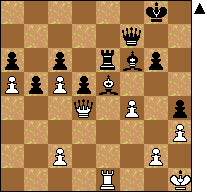
One month ago, I reported on my sixth and final game in a Pittsburgh Chess Club Tuesday night tournament. A lot of things came up after the end of that tournament that led me to not finish this report on how the critical final game went between my two opponents, Kurt Wallnau and Ed Dean, who had won their games against me in the fifth and fourth rounds, respectively.
Here’s my report on who won and on practical psychology and style in chess, and of course, what the definition of “best chess player” should be.
The complete annotated game
At your convenience, you can enjoy playing over the game Wallnau-Dean with my annotations, including diagrams.
Also, it was not until after this tournament that I learned from Ed that he has also been writing a chess blog all this time!! Check out his blog and his own comments about the critical sixth round game. You might find it interesting to compare our independent analyses of the game, as I did my analysis before learning of his own.
Overview of Wallnau-Dean
The stakes (update of 2013-01-17)
I should note that since Ed entered the final round with a perfect score of 5 points out of 5, but Kurt entered it with 4.5, Kurt had to win, not draw his game, in order to get first place. So he was under pressure to play for a win at all costs if he was going to have a chance at winning the tournament; Ed needed only a draw to win.
The opening
Ed stuck to his guns, and continued playing his d6-based opening systems in this game as Black. His preferred style is to avoid early crazy tactics in the opening and simply tenaciously develop and wait to get to the middlegame to invite complications. Even more than that, he seems to get stronger as the game progresses to the endgame. So his style is to make it to the endgame and win there.
This time, he played the Czech Defense, a kind of variant of the Pirc Defense:
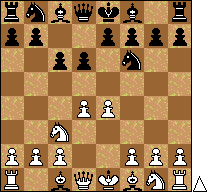
As often has been the case, Ed made some inaccuracies in the opening that led to a very dangerous position for him:
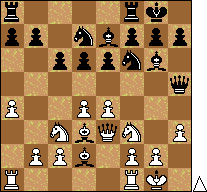
I actually saw this position in the game and thought, wow, Kurt could win already! But there were some problems. First, in the past several moves, Kurt had spent a huge amount of time thinking, because he clearly had achieved a very strong position. He was looking for the best moves, and in fact, he had played well up to this point. But now he was thinking really hard again, even though I stood there behind him seeing a virtually winning move that I thought was the whole point of Kurt’s play, Ne2 aiming to trap the Black Queen and therefore winning at least a Pawn:
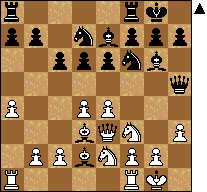
Instead, Kurt played a different move, missing a saving tactic by Black, and only too late saw the saving tactic.
The middle game
After realizing that he missed a good opportunity, Kurt still had a huge position but continued to miss other opportunities. Here, after Black played b5, White had to punish this attempted counterplay by capturing the Pawn en passant, which is the whole point of White’s a5 in the first place. After that, the thematic d5 would have been strong. But the game did not take that direction.
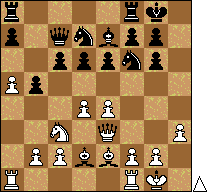
I was attending to my own game for a while before I looked at their game again. I was surprised to see this position:
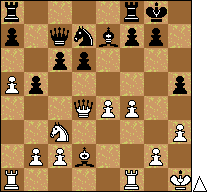
It was clear to me that after a difficult opening, Black had somehow now managed to fully equalize. I imagined that the game was going to be difficult for Kurt, who not only had spent a lot of time in the opening, but now had to deal with the fact of completely having lost his enormous opening advantage.
I completely stopped watching the game here, because my own game needed my full attention.
Critical position
A critical position in the game occurred when a nice thematic positional sacrifice, e5 followed by f5, would have been very strong:
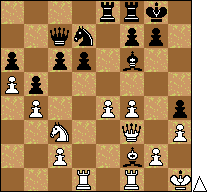
The most critical position
The most critical position occurred when Black made a blunder resulting in the Knight at d7 being vulnerable, and White did correctly break with e5 then:
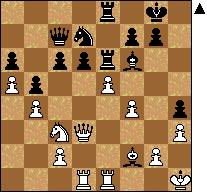
But then Kurt missed the instant win from exd6 followed by Rxed6 and then f5:

Instead, he made a series of errors leading to a position, which although it should be drawn because of things more or less being blocked up, leaves White on the defensive with weak Pawns:
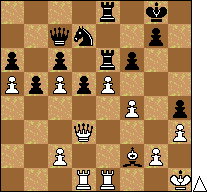
The final position before both players stopped keeping score
Both players continued trying to make something of the position, but slowly Black ended up with the more comfortable and safe prospects.
Finally, apparently Kurt was down to one minute on his clock and Ed was down to two minutes when they arrived at this position, the last at which either of them kept score. So the final moves in the game are lost.

The important thing to note is that objectively, White should be able to hold this position, but has a looser structure. Apparently, Kurt blundered during the time scramble and lost.
Ed won the game and therefore with his perfect score in the tournament, won the entire tournament, way ahead of everyone else. Congratulations!
The lesson here is that even if tactically a position is OK, having less time on the clock and having a looser structure is really dangerous.
What does it mean to be the best chess player?
I claim that Ed was the best chess player of us all in the tournament, and his winning it shows it.
You may have noticed that in the games I have covered on this blog so far featuring Ed, he was dead lost or almost losing at some point, or even multiple points, in each of them. So how can the “best” player have such terrible positions? What does it mean when you are always on the verge of losing but somehow win?
It means that the best player is not the one who sees everything (nobody does that anyway), but the one who perseveres, who fights to the end, who manages to get stronger at the end rather than weaker. Chess is not just about who had great opening preparation or who achieved a winning position. In the end, it’s about who actually wins, by hook or by crook.
It is very easy for someone who loses a game to complain afterwards that “I had a won position; I was better all along; I deserved to win”. A long time ago I might sometimes have engaged in that kind of excuse. But now, I simply accept the reality: whoever keeps on winning clearly has demonstrated having something of value (other than pure luck; here’s where official ratings are useful because they represent a long-term assessment of performance that is supposed to transcend transient fluctuations of luck). In Ed’s case, it is his willingness to defend, willingness to wait to strike, good time management skills, and command of simplified positions. To win consistently requires a whole package of skills, skills that go beyond just finding the “best” moves. Finding “good enough” moves at important points in the game and avoiding “worst” moves is important.
What next?
A week ago, when the upcoming Pittsburgh Chess Club tournament was announced, I decided to commit to playing in it. I have some ideas about how I want to approach this tournament differently from how I did in the ones last fall.
The tournament starts tonight! I will write more after my first round.
Conclusion
I wrapped up on the last Pittsburgh Chess Club Tuesday night tournament coverage by discussing the final critical game between my two opponents who had won games against me in the fourth and fifth rounds. I congratulate Ed for coming through difficult positions to win each of his games and winning the tournament, demonstrating his overall dominance as a chess warrior. I hope to face him again in some round of the annual Pittsburgh Chess Club Championship that starts tonight!
